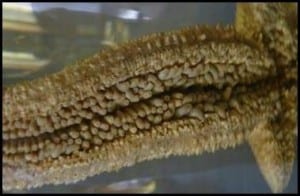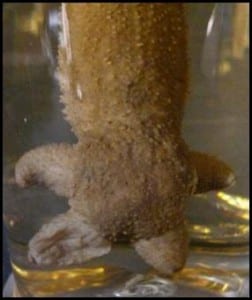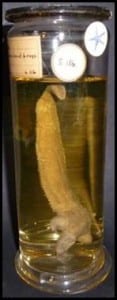Specimen of the Week: Week Eighteen
By Emma-Louise Nicholls, on 13 February 2012
 Whilst breaking my back hauling around panels of thick glass this week, I had just enough puff left in me to utter a ‘wow’ when I saw the specimen I subsequently chose for this week’s blog, for the first time. Although I have worked at the Grant Museum for quite some time everyday brings new discoveries. Beautiful and grotesque all at the same time, this week’s specimen of the week is:
Whilst breaking my back hauling around panels of thick glass this week, I had just enough puff left in me to utter a ‘wow’ when I saw the specimen I subsequently chose for this week’s blog, for the first time. Although I have worked at the Grant Museum for quite some time everyday brings new discoveries. Beautiful and grotesque all at the same time, this week’s specimen of the week is:
**!!!The common starfish!!!**… mid-regeneration!
1) The common starfish can have between four and six arms (the majority stick to tradition and have five). Each arm sports a row of spines along the top for protection and several rows of ‘tube-feet’ along the bottom for locomotion. The tube feet (see image right) work by hydraulics controlled by the water-vascular system, and are adorned with suckers for grip.
2) The suckers are also used to prise open the shell of their prey. Then, in a tribute to the most grotesque Hammer Horror, they insert lobes of their stomach into the prey and digest it whilst it is still alive. Sounds messy. Not a guest to invite to formal occasions methinks.
3) Although the Grant Museum of Zoology has a number of specimens of the common starfish, the specific specimen highlighted this week is very special. It is an arm. Not very impressive? Ok- it is an arm… that has started to grow its own body. There is no need to re-read it, you read it correctly the first time. If a starfish’s arm finds itself without a body, it can regenerate an entire animal, so long as it has been careful to retain at least a 5th of the central disc. The process takes up to a year to complete. Some species use this as a method of asexual reproduction. They will cast off one of their arms which will, over time, grow itself a new body. The ‘offspring’ is genetically identical.
4) Common starfish are compact killing machines. They hunt down brittlestars, molluscs, sea urchins and worms. They even ‘keep it in the family’ by partaking in a little pseudo-cannibalism and eating other species of starfish.
5) Hear the one about the dog with no nose? How does he smell? Awful. The same is true for the common starfish. Whilst they have a good sense of smell themselves (despite no obvious hooter), many of their prey species can smell the starfish coming and having done so, bolt in the other direction. Quite right too given their stomach projecting, eat-me-while-I’m-still-alive, table manners.
Our starfish arm, with body attached, is available for your viewing pleasure at the Grant Museum near you. See if you can spot it through our shiny new glass fronted display cases, complete with twinkly spot lights. I’m not sure which is more beautiful.
 Close
Close




